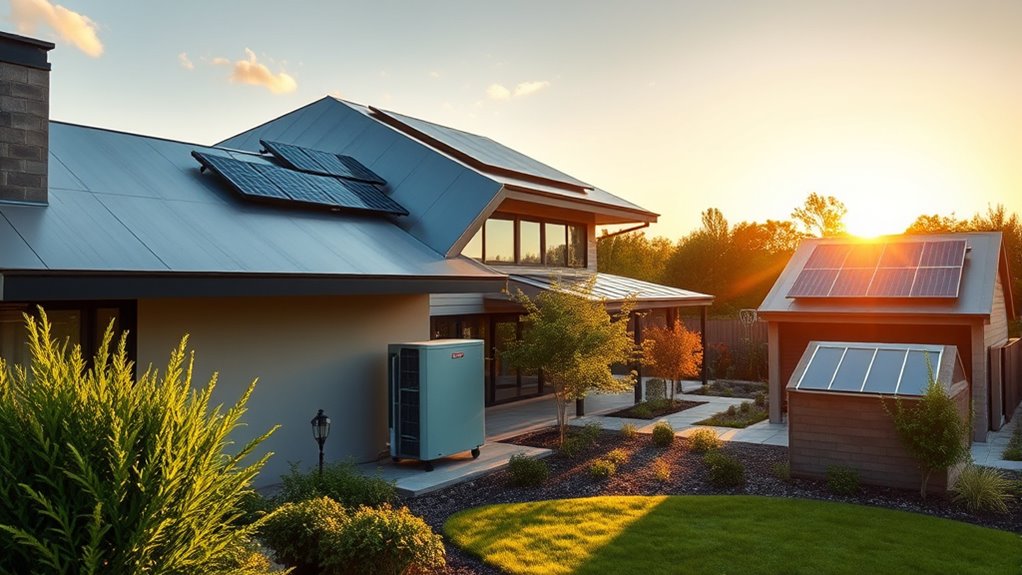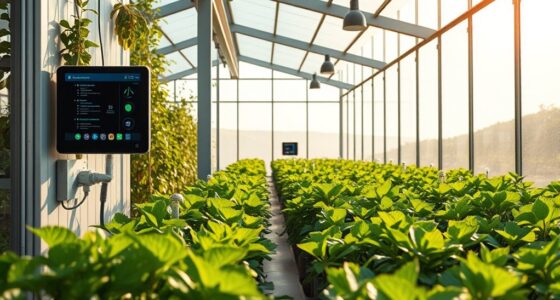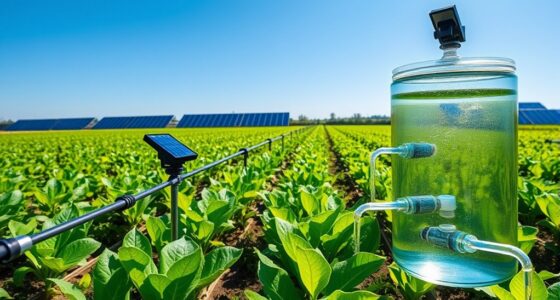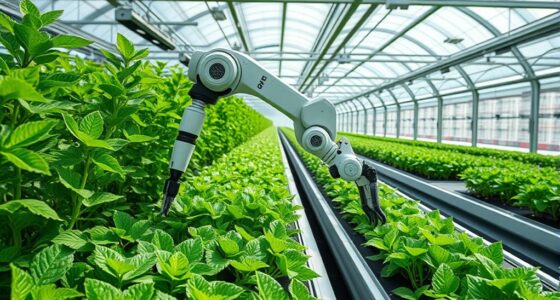To improve your home’s heating efficiency, consider solar panels and geothermal systems. Solar panels convert sunlight into electricity, lowering energy bills and relying on renewable sources. Geothermal systems use underground temperatures for consistent, cost-effective heating all year round. Both options reduce your reliance on fossil fuels and environmental impact. With advancements in technology and professional guidance, you can optimize these solutions for your climate and budget. Exploring further will reveal how to maximize these innovative options.
Key Takeaways
- High-efficiency solar panels maximize power output with less space, reducing costs and reliance on renewable energy.
- Geothermal systems provide consistent, energy-efficient heating suitable for various climates, especially cold winters.
- Proper insulation and smart technology optimize system performance and energy savings in solar and geothermal setups.
- Both options require upfront investment but significantly lower long-term energy bills and environmental impact.
- Consulting professionals ensures proper system selection, installation, and integration with home energy needs.
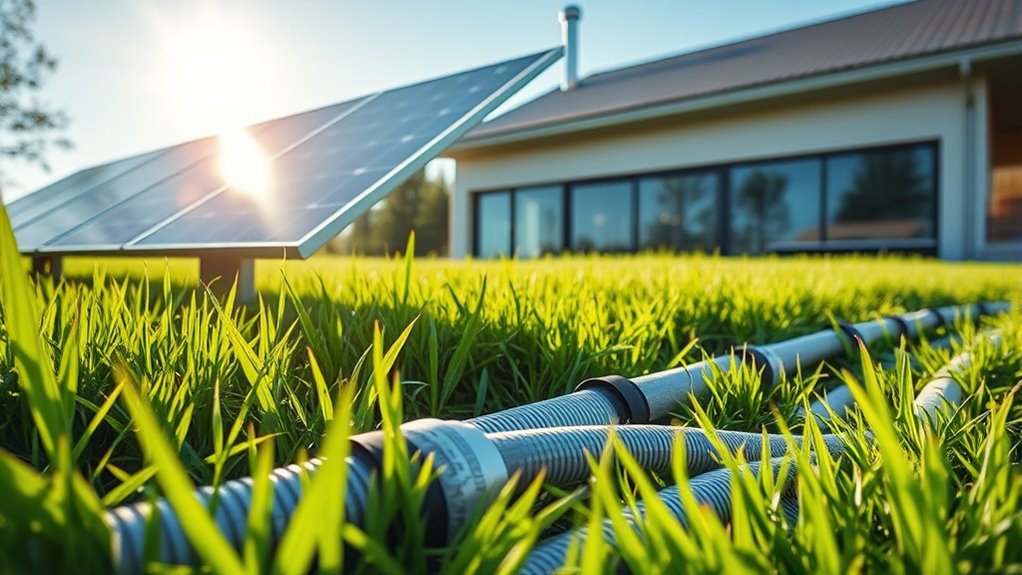
When it comes to staying warm without soaring energy bills, choosing efficient heating solutions is vital. You want options that maximize energy use while minimizing costs, and understanding your choices can make all the difference. Solar panel efficiency plays a pivotal role if you’re considering solar-powered heating systems. Modern solar panels are more efficient than ever, converting sunlight into usable energy at higher rates. This means you can generate more power with fewer panels, reducing upfront costs and space requirements. By investing in high-efficiency solar panels, you guarantee that your heating system relies on renewable energy that’s both sustainable and economical. Pairing this with proper insulation can further boost overall efficiency, helping you keep warmth inside while limiting energy waste. As the Best Beaches showcase diverse environments, choosing the right heating solution depends on your local climate and sunlight exposure. Another highly efficient option is a geothermal system installation. Geothermal heating taps into the stable underground temperatures, providing a reliable source of warmth throughout the year. Installing a geothermal system involves drilling into the ground and setting up a network of pipes that circulate a fluid to transfer heat. This process is remarkably energy-efficient because it leverages the Earth’s natural thermal properties, requiring less electricity than conventional systems. Once installed, geothermal systems can considerably reduce your heating bills over time, often paying for themselves through energy savings. They also tend to have low maintenance needs and a long lifespan, making them a smart investment for homeowners seeking sustainable solutions. When evaluating these options, consider how each aligns with your home’s size, location, and energy needs. Solar panel efficiency depends on sunlight availability and the quality of panels used, so if you live in a sunny climate, solar heating can be highly effective. Conversely, geothermal systems work well in various climates and are particularly advantageous if your area experiences cold winters, as they can provide consistent heat regardless of outdoor temperatures. Both systems require an initial investment, but the long-term savings and environmental benefits often outweigh the upfront costs. In addition, understanding energy-efficient heating options can help you make informed decisions that benefit both your wallet and the planet. Implementing energy-efficient heating solutions isn’t just about saving money; it’s about reducing your ecological footprint. You’ll enjoy a cozy home while making a positive impact on the planet. Whether you opt for high-efficiency solar panels or a geothermal installation, choosing the right system involves understanding your specific needs and consulting with professionals who can guide you through installation and optimization. With the right setup, you’ll stay warm year-round without breaking the bank or harming the environment. Additionally, incorporating advanced technology such as smart thermostats can further optimize energy use and enhance comfort. For example, integrating renewable energy sources can create a more resilient and sustainable home heating system.
Frequently Asked Questions
What Are the Initial Costs of Installing Solar Versus Geothermal Heating?
You’ll find that installation costs differ between solar and geothermal heating. Solar panel setups usually have lower initial costs, often ranging from $10,000 to $30,000, but can be reduced with financial incentives like tax credits. Geothermal systems are pricier upfront, typically costing $20,000 to $50,000, but they offer long-term savings. Both options benefit from incentives, which can make your investment more affordable initially.
How Long Do Different Heating Systems Typically Last?
Your heating system’s lifespan can feel like an eternity or vanish in the blink of an eye. Typically, solar panels last 25-30 years, showcasing incredible durability compared to geothermal systems, which usually last 20-25 years. Gas furnaces often endure 15-20 years. The durability comparison highlights solar’s impressive resilience, making it a smart long-term investment, while proper maintenance can extend your system’s lifespan markedly.
Can These Systems Be Combined With Existing Home Heating?
You can definitely integrate these systems with your existing home heating, thanks to retrofit compatibility. Combining traditional systems with solar or geothermal options allows you to enhance efficiency and reduce energy costs. You’ll want to assess your current setup and work with professionals to guarantee seamless integrating systems. This way, you maximize your home’s comfort while benefiting from renewable energy, making your heating system more sustainable without replacing everything entirely.
What Maintenance Is Required for Solar and Geothermal Heating Systems?
Ever wondered what it takes to keep your solar and geothermal systems running smoothly? You’ll need to regularly check and replace system filters to guarantee optimal performance. Additionally, corrosion prevention is essential; inspect for signs of corrosion and apply protective measures when needed. These simple maintenance tasks help extend your system’s lifespan and keep your home warm efficiently, so you can enjoy the benefits without unexpected breakdowns.
Are There Government Incentives for Installing These Alternative Heating Solutions?
You may be eligible for government grants and tax incentives when you install solar or geothermal heating systems. These programs aim to encourage renewable energy use and can substantially offset installation costs. Check with local or federal agencies to see what incentives are available in your area. Taking advantage of these financial benefits can make adopting eco-friendly heating solutions more affordable, helping you save money long-term while reducing your carbon footprint.
Conclusion
Switching to efficient heating solutions like solar or geothermal can save you money and reduce your carbon footprint. For example, imagine installing a geothermal system in your home—over time, you’ll notice lower energy bills and a warmer, more comfortable space. By choosing the right system for your needs, you not only improve your home’s efficiency but also contribute to a greener planet. It’s a smart move that benefits both your wallet and the environment.
